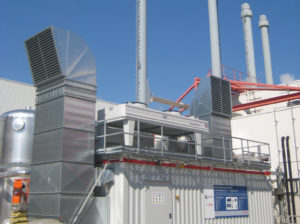Reducing our carbon footprint
An Aspen Bad Oldesloe initiative
 From April 2016, the carbon footprint of the Aspen Bad Oldesloe site was reduced following the installation of a combined heat and power plant (CHP) with an electrical capacity of 600 KW.
From April 2016, the carbon footprint of the Aspen Bad Oldesloe site was reduced following the installation of a combined heat and power plant (CHP) with an electrical capacity of 600 KW.
How CHP works:
CHP is an engine that is connected to an electrical generator to produce electricity. Waste heat is recovered from the engine cooling circuit and from the exhaust to produce steam and heating water. The engine is usually either a gas turbine – for larger units above 5 MW, or a reciprocating engine as in the case of the Aspen Bad Oldesloe CHP.
Ulrich Huetz, Engineering and Energy Manager said, “A CHP can only be operated beneficially if the size of the installed unit matches the energy profile of the site in terms of warm water, steam and electrical energy consumption. The Aspen unit is sized to operate between 6000 and 7000 hours per year. In winter, it will nearly cover the full electrical demand of the site. In the first weeks of operation the unit even exceeded the planned conversion ratios and is operating at a total efficiency of 90%.”
Generating environmental benefits and cost savings:
The operation of the CHP will generate a reduction of 833 tons of CO2 each year by producing electrical and heating energy up to 48% more efficiently compared to the standard separated generation of warm water, steam and electrical supply from the German power grid.
Based on the overall higher efficiency of the CHP process and tax benefits from the German program for environmentally friendly energy generation, the site will save an average €110,000 per year.
In addition to the environmental and financial benefits, the CHP also contributes to business continuity. Together with the already installed emergency power generators, the site can operate fully independently from the external power grid if the municipal supply is interrupted.
“We are already investigating means to generate even further savings by integrating the CHP capacity into the German power grid”, said Ulrich Hütz. “In case the load of the German power grid fluctuates, perhaps through an unplanned shutdown of a main power plant in Germany, or if solar and wind energy stations are not delivering as planned, decentralized units such as the CHP in Bad Oldesloe can help to stabilize the German power grid. Bad Oldesloe might therefore have the opportunity to support the overall CO2 reduction targeted by Germany.”
The project is one of many energy and CO2 savings projects that the site has implemented, leading to a year-on-year reduction of its energy and CO2 footprint.
An additional project being conducted includes a conceptual study on how the site sprinkler tanks for fire protection can be used as thermal storage for cold water to increase the overall efficiency of the generation of cooling energy.


 Alemania
Alemania Canadá
Canadá Español latino america
Español latino america Francia
Francia Mauricio
Mauricio Países Bajos
Países Bajos Australia
Australia China
China Filipinas
Filipinas Japón
Japón Malasia
Malasia Taiwán
Taiwán Ethicare
Ethicare Beta Healthcare
Beta Healthcare Kama
Kama Níger
Níger Shelys
Shelys Ghana-Kama
Ghana-Kama  Kenia-BETA HEALTHCARE
Kenia-BETA HEALTHCARE  MAURICIO
MAURICIO  Sudáfrica-FCC
Sudáfrica-FCC  Sudáfrica-HOLDINGS
Sudáfrica-HOLDINGS  Sudáfrica-Pharmacare
Sudáfrica-Pharmacare  Tanzania-SHELYS
Tanzania-SHELYS  CANADÁ
CANADÁ  China
China  Filipinas
Filipinas  Malaysia
Malaysia  Alemania
Alemania  FRANCIA
FRANCIA  PAÍSES BAJOS
PAÍSES BAJOS  Países Bajos-Aspen API
Países Bajos-Aspen API  Rusia
Rusia